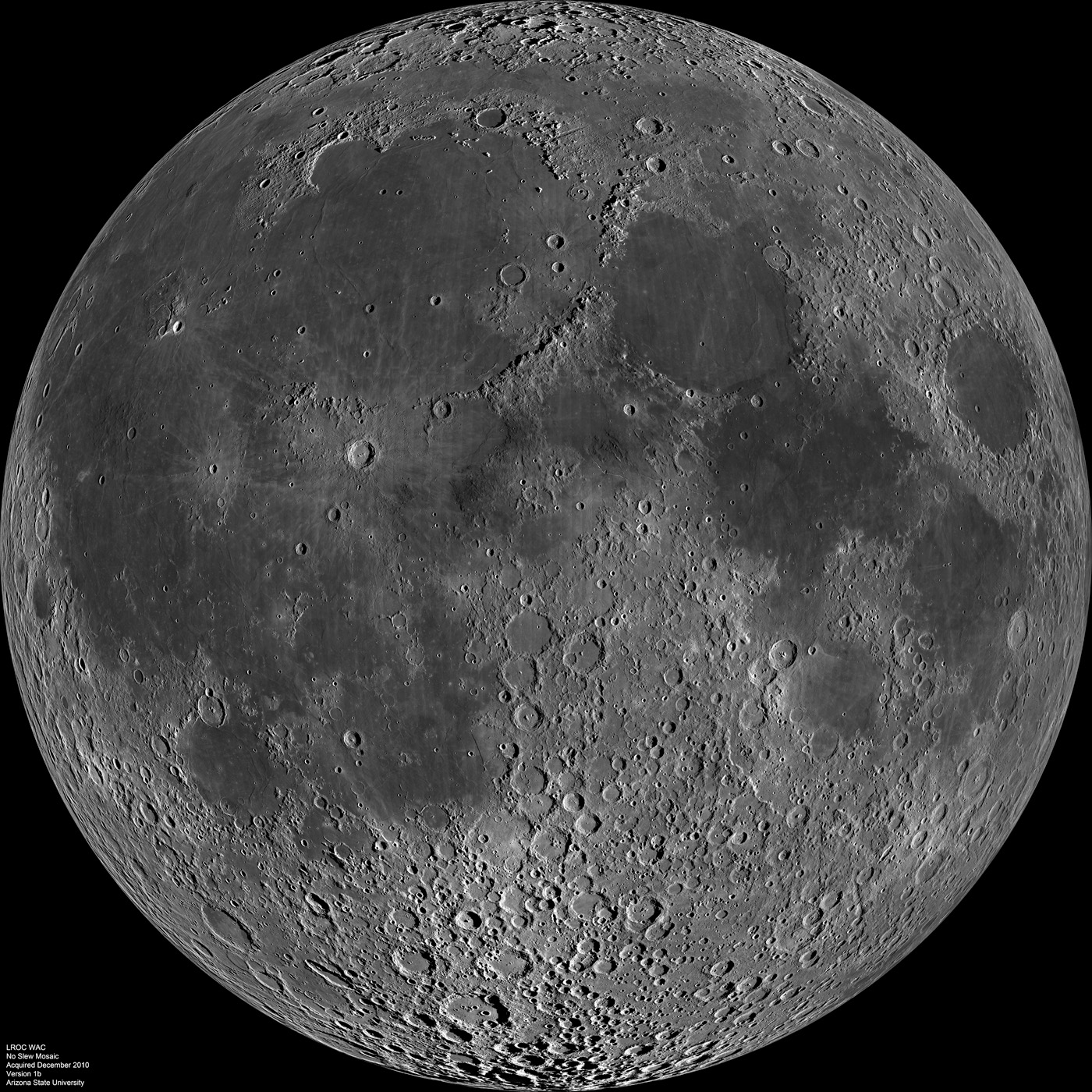
Posted on 07/20/2025 1:07:31 PM PDT by MtnClimber
Explanation: About 1,300 images from the Lunar Reconnaissance Orbiter spacecraft's wide angle camera were used to compose this spectacular view of a familiar face - the lunar nearside. But why is there a lunar nearside? The Moon rotates on its axis and orbits the Earth at the same rate, about once every 28 days. Tidally locked in this configuration, the synchronous rotation always keeps one side, the nearside, facing Earth. As a result, featured in remarkable detail in the full resolution mosaic, the smooth, dark, lunar maria (actually lava-flooded impact basins), and rugged highlands, are well-known to earthbound skygazers. To find your favorite mare or large crater, just follow this link or slide your cursor over the picture. The LRO images used to construct the mosaic were recorded over a two week period in December 2010.
For more detail go to the link and click on the image for a high definition image. You can then move the magnifying glass cursor then click to zoom in and click again to zoom out. When zoomed in you can scan by moving the side bars on the bottom and right side of the image.


🪐 🌟 🌌 🍔
Wow.
Cool.
The Moon rotates on its axis and orbits the Earth at the same rate, about once every 28 days. Tidally locked in this configuration, the synchronous rotation always keeps one side, the nearside, facing Earth.
That has always struck me as odd. Seems like a near impossibility that both the moon's rotation and its orbit around Earth would be precisely the same.
The mass may not be symmetrical. If one side has more mass it will have more gravitational attraction to Erf.
>P<
I see what you’re saying but the Moon does present all sides to the Earth doesn’t it?
It is the Sun that one side of the Moon is always facing. No?
Incredible detail! 👍👍👍🔭🔭🔭🙂
Interesting how the southern part has so many more craters.
No, the same side of the moon always faces Earth. The phase of the moon is caused by the shadow cast by Earth as the moon orbits.
I need to correct. The phase of the moon is caused by the half of the moon facing the sun and the relation to Earth. The shadow or Earth (or of the moon) is what happens in eclipses.
Great pictures.
I’ll take your word for it but I’ve always thought that the same side of the Moon always faced the Sun and the phases were caused by the changing relationship of the Moon to the Sun and the Earth in relation to its orbit around Earth.
A full moon being when the Moon is in ‘behind’ the Earth in relation to the Sun and therefore, whenever it is visible in the sky by virtue of the Earth’s orbit, the entire disc of the Moon is sunlit.
The opposite occurs with the New Moon because the Moon is relatively directly between the Earth and Sun so whenever the Moon is in the sky, owing to the Earth’s orbit, the entire disc is dark.
That’s where people get confused. I know someone already explained it to you, but I’ll just add that the ‘dark’ side of the Moon, while never facing the Earth, does face the Sun so it’s not always dark. I think many people believe it’s pitch black all the time on one side.
I did.
It also wobbles around a bit, so astronomers get to peek over the edges just a bit. I was looking for this image, but thought it would be from a different Freeper. I didn’t remember that I’d posted it in the past.
https://freerepublic.com/focus/chat/3691563/posts?page=4#4
It’s often called tidally locked, the physics term is ‘tidal transfer of momentum’. That means that a body in (prograde) orbit around another body (and indeed, the parent body also experiences tidal transfer of momentum) loses rotational momentum as it pushes against the other body.
Presumably the Moon used to have a faster rate of rotation, but thanks to the fact that the Earth is about 100 times the mass of the Moon, the Moon ran out of rotational momentum first.
The Earth continues to push the Moon away and lose a tiny bit of rotational momentum as it does this. Dunno the math, but it’s possible that the Earth will push the Moon far enough away that the Moon will be lost, at least for some period of time. That’ll be a bad crazy day, but it won’t be anytime soon.
The wobble in the pic at the top link is probably due to the lumpiness of both Earth and Moon:
Earth:
https://freerepublic.com/focus/news/952189/posts
https://freerepublic.com/focus/chat/2697901/posts
https://freerepublic.com/focus/chat/3237279/posts
Moon:
https://freerepublic.com/focus/news/2186775/posts
Mercury:
https://freerepublic.com/focus/chat/3286370/posts
My guess is, the Chandler Wobble is due to the lumpy Earth and lumpy Moon interactions:
https://freerepublic.com/tag/chandlerwobble/index?tab=articles
Disclaimer: Opinions posted on Free Republic are those of the individual posters and do not necessarily represent the opinion of Free Republic or its management. All materials posted herein are protected by copyright law and the exemption for fair use of copyrighted works.